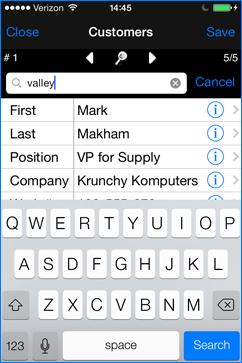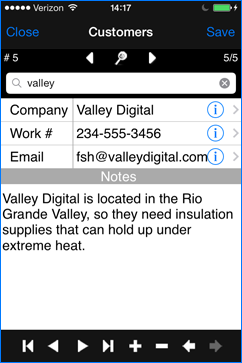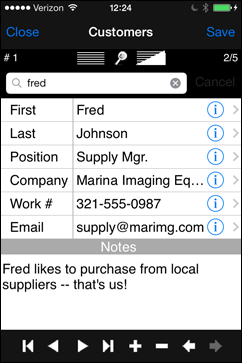Filtering
and Searching
Return to User Guide Index
iData Mobile Plus provides two ways to examine records that contain specific text.
One way is to "filter" records, so that only those records that contain the desired text are displayed.
The other is to search for the desired text, starting at the current record and finding the next instance of that "target".
These two methods can be used together by first filtering the records, then performing a search for the target text.
The Status Bar and Find Box
When a datafile is opened, it will look something like this:

The Navigation Bar
In the preceding example, you see the name of the datafile, "Customers", at the top of the screen, with a blue "Close" button at the left and a blue "Save" button at the right. This is the "navigation bar".
The Status Bar
Below that is the "status bar".
At the left is the number of the current record ( #1 ). At the right are two numbers separated by a / character( 5/5 ).
The number on the left is the Selected Record Count. The number on the right is the Total Record Count.
In the center are three buttons. The magnifying glass in the center is the search/filter Toggle button.
The triangles on the left and right are the Backward Search and Forward Search buttons.
When the Toggle button is tapped, these will change to filter buttons.
The button on the right is the Record Filter button. The one on the left is the Select All button.
The uses of these buttons will be explained below.
Entering Multiple Targets
Below the status bar is the search field. This is where you enter search target text or record filter text.
There are two styles of target entry for both search targets and filter text. You can select the style you want to use by turning Use Classic Search Entry on or off in the Datafile Settings window.
The default style is referred to as Classic Search Entry, because it has been used in Mac versions of iData since 2002.
In Classic Search Entry, a string of text containing any characters is treated as a single, unified target.
The exception is that multiple targets are delimited using && -- double ampersands.
So, the following line is a single target:
Ben & Jerry's Ice Cream
The following is two targets:
Ben & Jerry's&&Ice Cream
And the following is three targets:
Ben & Jerry's&&Ice&&Cream
The other style of target entry is Search Engine Entry. This style is a modified version of target entry used in search engines on the Web, such as Google and Yahoo!
In iData's version of Search Engine Entry style, a string of text in the search box is divided into multiple targets by spaces. Unlike most Web-based search engines, punctuation characters are not treated a target dividers.
To treat a string that includes spaces as a single target, you must enclose it it double quotation marks.
So, the following line is five targets:
Ben & Jerry's Ice Cream
The following is one target:
"Ben & Jerry's Ice Cream"
And the following is three targets:
"Ben & Jerry's" Ice Cream
Searching for Text in a Datafile
First, if the Record Filter and Select All buttons are showing, tap the Toggle button so that the Backward Search and Forward Search buttons appear.
To search for text, tap in the search field and type in the text that you want to find ("the target text"). (Searches are case insensitive.) Then, tap the Search button on the keyboard.
If you prefer, you can click the Forward Search button or the Backward Search button. In either case, the keyboard will go away.

If you decide not to perform the search, tap the Cancel button next to the search field to dismiss the keyboard.
If the search is successful, a sort of musical "plunk" will play, and the record in which the target text was found will be displayed.
After each search, if the target text is not in view, the view will be scrolled to show it.
This shows the word "valley" found in a field:

Note that the Company field is scrolled to the top of the window.
When the target is found in the Notes area, it will be shown as white text on a red background:

As soon as you do anything that causes the Notes area to redraw, such as going to another record, rotating the iPhone, or performing another search, the highlighted text will revert to the normal black on white.
If the search fails, the iPhone will vibrate briefly. This will alsdo occur when you have found all instances of the target in the datafile. After that, you can repeat the search.
Repeating a Search
Once you have some text in the search field, you can continue to search by clicking the Forward Search button or the Backward Search button.
Filtering Records in a Datafile
First, if the Backward Search and Forward Search buttons are showing, tap the Toggle button so that the Record Filter and Select All buttons buttons appear.

Next, tap in the search field and type the text that you want to use as a filter ("fred" in the example below).

To see only records that contain the filter text, tap the Search key or the Record Filter button. In the example below, the Selected Record Count now shows 2, where it showed 5 before filtering.

Now, when you use the toolbar buttons to move through the records, you will see only those "selected records" that contain the filter text.
Selecting All Records
Filtering and searching both work only on the currently selected records.
If you apply a different filter, it will select from only those records that are already selected. This gives you a way to filter records based on multiple criteria.
Even if you tap the Toggle button to go back to search mode, the selected records will be the only ones that are searched and displayed.
In order to undo any filtering, simply tap the Select All button. After doing that, you will be able to see that the Selected Record Count and the Total Record Count are the same.